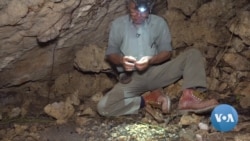ໃນປີ 1945, ກອງກໍາລັງຂອງສະຫະລັດ ໄດ້ບຸກເຂົ້າເກາະໂອກິນາວາ ຂອງຍີ່ປຸ່ນ, ຈຶ່ງກໍ່ໃຫ້ເກີດການຕໍ່ສູ້ທີ່ນອງເລືອດທີ່ສຸດຢູ່ໃນມະຫາສະໝຸດ ປາຊີຟິກ. ຜູ້ຊາຍຄົນນຶ່ງ ທີ່ໃຊ້ເວລາຫຼາຍທົດສະວັດຊອກຫາຊາກສົບຂອງຜູ້ ເສຍຊີວິດທີ່ຍັງຄົງຢູ່ທີ່ນັ້ນ ມີຄວາມກັງວົນວ່າ ໂອກິນາວາ ຈະມີຄວາມສ່ຽງອີກ ຄັ້ງນຶ່ງ, ໃນຂະນະທີ່ຄວາມເຄັ່ງຕຶງລະຫວ່າງ ສະຫະລັດ ແລະ ຈີນ ເພີ້ມຂຶ້ນ. ເຮັນຣີ ຣິດຈ໌ເວລ ມີລາຍງານຈາກເກາະໂອກິນາວາ, ເຊິ່ງ ທິບສຸດາ ມີລາຍລະ ອຽດມາສະເໜີທ່ານ ໃນອັນດັບຕໍ່ໄປ.
ຖໍ້າທີ່ເປັນປ່າຕຶບດົງໜາຂອງເກາະໂອກິນາວາ ຍັງຄົງເຊື່ອງຊ່ອນບັນດາພົນລະ ເຮືອນ ແລະທະຫານຫຼາຍພັນຄົນ ພວກເຂົາເຫຼົ່ານັ້ນ ໄດ້ເສຍຊີວິດໃນຊ່ວງສຸດ ທ້າຍແຫ່ງການຕໍ່ສູ້ຂະໜາດໃຫຍ່ຂອງສົງຄາມໂລກຄັ້ງທີສອງ.
ທ່ານ ກູຊິເກັນ ທາກາມັດສຸ (Gushiken Takamatsu), ຜູ້ກໍ່ຕັ້ງມູນນິທິ ກາມາຟູຢະ (Gamafuya) ກ່າວວ່າ:
“ມັນແມ່ນກະໂຫລກ. ຜູ້ທີ່ເສຍຊີວິດຄົນນີ້ ແມ່ນພົນລະເຮືອນ ຫຼື ທະຫານ? ຂ້ອຍຄິດວ່າ ນີ້ແມ່ນເຄື່ອງພົ່ນໄຟທີ່ເຮັດໃຫ້ເປັນແນວນີ້. ທຸກຢ່າງມັນຖືກໄໝ້ ໄປໝົດ.”
ເປັນເວລາຫຼາຍທົດສະວັດແລ້ວ ບັນດາກະດູກທັງຫຼາຍ ໄດ້ນອນຢູ່ທີ່ນີ້ໂດຍບໍ່ ໄດ້ຖືກລົບກວນ, ໃນຂະນະທີ່ຍີ່ປຸ່ນ ພະຍາຍາມທີ່ຈະລືມຊ່ວງເວລາຂອງສົງ ຄາມທີ່ຜ່ານມາຂອງເຂົາເຈົ້າ.
ນັັ້ນ ເປັນສິ່ງທີ່ໜ້າອັບອາຍຂອງຊາດ, ທ່ານ ກູຊິເກັນ ທາກາມັດສຸ ກ່າວ. ຜູ້ທີ່ເປັນຊາວພື້ນເມືອງຂອງເກາະໂອກິນາວາ ທີ່ກໍ່ຕັ້ງອົງການການກຸສົນ ‘Gamafuya’ ຫຼື ‘ຜູ້ຂຸດຖໍ້າ’, ເຊິ່ງເປັນກຸ່ມອາສາສະໝັກນ້ອຍໆ ທີ່ໄດ້ພະຍາ ຍາມຊອກຄົ້ນຫາສົບຜູ້ເສຍຊີວິດ ທີ່ຍັງຄົງຫຼົງເຫຼືອຢູ່ໃນຊ່ວງສົງຄາມ ແລະສົ່ງ ພວກເຂົາເຈົ້າຄືນຫາລູກຫຼານຂອງພວກເຂົາທີ່ຍັງມີຊີວິດຢູ່.
ທ່ານກູຊິເກັນ ທາກາມັດສຸ ກ່າວວ່າ:
“ຕອນທີ່ຂ້ອຍຍັງນ້ອຍ, ຂ້ອຍຈະເຫັນກະໂຫຼກໃສ່ໝວກເຫຼັກກັນກະທົບຕອນທີ່ ຂ້ອຍອອກໄປຫຼິ້ນຢູ່ເທິງພູ. ຕອນທີ່ຂ້ອຍເປັນເດັກນ້ອຍ, ມັນເຮັດໃຫ້ຂ້ອຍຮູ້ສຶກ ຢ້ານ. ແລະເມື່ອຂ້ອຍມີອາຍຸຫຼາຍຂຶ້ນ ແລະເປັນຜູ້ໃຫຍ່ເຕັມໄວອາຍຸແລ້ວ, ຂ້ອຍ ໄດ້ສັງເກດວ່າ ເປັນຫຍັງບັນດາຜູ້ເຄາະຮ້າຍໃນຊ່ວງສົງຄາມ ຍັງຄົງຖືກປະຖິ້ມ ໄວ້ຢູ່ບ່ອນນີ້.”
ໃນຊ່ວງເວລາ 40 ປີຂອງການຊອກຄົ້ນຫາ, ທ່ານ ທາກາມັດສຸ ໄດ້ຄົ້ນພົບສົບ ຜູ້ເສຍຊີວິດຫຼາຍກວ່າ 700 ຄົນ. ລັດຖະບານຍີ່ປຸ່ນ ບໍ່ໄດ້ສະໜອງການຊ່ວຍ ເຫຼືອໃດໆທາງການເງິນ. ໃນປີ 2011, ພວກເຂົາເຈົ້າສະເໜີການກວດກາ DNA. ແຕ່ລະບົບຂໍ້ມູນແມ່ນນ້ອຍຫຼາຍ, ແລະຍາດຕິພີ່ນ້ອງຂອງຜູ້ເສຍຊີວິດ ຈໍານວນຫຼາຍກໍເບິ່ງຄືວ່າເສຍຊີວິດໄປແລ້ວເຊັ່ນກັນ.
ທ່ານກູຊິເກັນ ກ່າວວ່າ:
“ພວກເຮົາເປັນອາສາໝັກ 1 ຫຼື 2 ຄົນ. ໃນຄວາມເປັນຈິງແລ້ວ, ລັດຖະບານ ຈະຕ້ອງເປັນຜູ້ເຮັດໜ້າທີ່ນີ້. ແຕ່ເຖິງແມ່ນພວກເຮົາຖາມ, ພວກເຂົາເຈົ້າກໍປະຕິ ເສດ. ຂ້ອຍຢາກສະແດງໃຫ້ເຫັນ ຖ້າພວກເຈົ້າຫາກຊອກຫາສົບທີ່ຍັງຫຼົງເຫຼືອຢູ່ ໃນວິທີນີ້, ພວກເຈົ້າກໍສາມາດເຫັນເຂົາໄດ້. ວຽກດັ່ງກ່າວນີ້ ຍັງບໍ່ທັນສິ້ນສຸດລົງ ເທື່ອ.”
ຈົນເຖິງຂະນະນີ້, ທ່ານ ທາກາມັດສຸ ໄດ້ລະບຸສົບຂອງຜູ້ເສຍຊີວິດໄດ້ແລ້ວ 4 ຄົນ ແລະສົ່ງພວກເຂົາໄປໃຫ້ຍາດພີ່ນ້ອງທີ່ຍັງມີຊີວິດຢູ່ ຂອງພວກເຂົາເຈົ້າ ແລ້ວ.
ທ່ານທາກາມັດສຸ ກ່າວວ່າ:
“ທໍາອິດ ພວກເຂົາເຈົ້າບໍ່ເຊື່ອຂ້ອຍ. ພວກເຂົາເຈົ້າມີຄວາມສົງໄສ ແລະຄິດວ່າ ມັນເປັນການຕົວະຕົ້ມ. ແຕ່ຂ້ອຍເຂົ້າໃຈວ່າພວກເຂົາເຈົ້າຮູ້ສຶກແນວໃດ. ເປັນເວ ລາ 70 ປີທີ່ພວກເຂົາເຈົ້າບໍ່ໄດ້ຍິນຫຍັງເລີຍ, ແລະພວກເຂົາເຈົ້າໄດ້ຮັບໂທລະ ສັບທີ່ກ່າວວ່າ ຍາດຕິພີ່ນ້ອງຂອງພວກເຂົາເຈົ້າຖືກຄົ້ນພົບແລ້ວ. ມັນຄືກັນກັບວ່າ ພໍ່ຂອງພວກເຂົາເຈົ້າກໍາລັງກັບຄືນບ້ານ.”
ມີທະຫານຍີ່ປຸ່ນປະມານ 90 ພັນຄົນ ແລະ ທະຫານສະຫະລັດ 12 ພັນຄົນ ຖືກສັງຫານ ໃນຂະນະທີ່ກອງກໍາລັງຂອງສະຫະລັດ ບຸກໂຈມຕີເຂົ້າໄປເທິງ ເກາະໂອກິນາວາໃນເດືອນເມສາ 1945. ມີການຄາດຄະເນວ່າ ພົນລະເຮືອນ ຫຼາຍກວ່າ 100 ພັນຄົນໄດ້ເສຍຊີວິດ. ປະຊາຊົນທີ່ອາໄສຢູ່ໃນທ້ອງຖິ່ນຖືກ ບອກວ່າ ພວກເຂົາເຈົ້າຈະຖືກທຸບຕີ ແລະທໍາການສັງຫານໂດຍກອງທັບ ສະຫະລັດ. ຫຼາຍຄົນຫຼົບລີ້ຢູ່ໃນຖໍ້າຂອງເກາະ. ການຍອມຈໍານົນແມ່ນຖືກຫ້າມ. ບາງຄົນກໍຂ້າໂຕຕາຍ.
ທ່ານກູຊິເກັນ ກ່າວວ່າ:
“ປະຊາຊົນທີ່ອາໄສຢູ່ທີ່ນີ້ ມີຄວາມຢ້ານກົວກອງທັບອາເມຣິກັນຫຼາຍ. ແນວໃດ ກໍຕາມ, ມັນເປັນພຽງຊ່ວງເວລາຫຼັງຈາກທີ່ພວກເຂົາເຈົ້າກາຍມາເປັນນັກໂທດ ຂອງສົງຄາມ ທີ່ພວກເຂົາເຈົ້າໄດ້ເຂົ້າໃຈວ່າ ມັນບໍ່ແມ່ນດັ່ງກໍລະນີນັ້ນ, ເຊິ່ງກອງ ທັບ ສະຫະລັດ ໄດ້ສະໜອງອາຫານ ແລະຢາປົວພະຍາດໃຫແກ່ປະຊາຊົນຢູ່ ທີ່ນີ້.”
ປັດຈຸບັນ, ສະຫະລັດ ແລະ ຍີ່ປຸ່ນ ເປັນພັນທະມິດທີ່ໃກ້ຊິດກັນ. ເກາະ ໂອກິນາວາ ມີທະຫານ ສະຫະລັດ ປະຈໍາການຢູ່ເກືອບ 30 ພັນຄົນ.
ຖານທັບໃໝ່ຂອງທະຫານ ອາເມຣິກັນ ກໍາລັງໄດ້ຮັບການສ້າງຕັ້ງຂຶ້ນຢູ່ທາງ ພາກຕາເວັນອອກຂອງເກາະ. ດິນບາງສ່ວນທີ່ໃຊ້ເຂົ້າໃນການກໍ່ສ້າງ ແມ່ນຂຸດ ມາຈາກພາກໃຕ້ຂອງເກາະໂອກິນາວາ, ຢູ່ບໍລິເວນທີ່ກອງກໍາລັງ ສະຫະລັດ ຂຶ້ນຝັ່ງມາໃນປີ 1945. ເຈົ້າໜ້າທີ່ທ້ອງຖິ່ນຢືນຢັນລາຍລະອຽດຂອງການກວດ ສອບກ່ອນມີການຂຸດຂຶ້ນມາ, ແຕ່ທ່ານ ທາກາມັດສຸ ກ່າວວ່າມັນເບິ່ງຄືວ່າ ມີສ່ວນປະສົມຂອງທະຫານຍີ່ປຸ່ນ ແລະທະຫານອາເມຣິກັນ ທີ່ຍັງຫຼົງເຫຼືອຢູ່.
ທ່ານກ່າວວ່າ:
“ນີ້ຄືການບໍ່ເຄົາລົບຕໍ່ຜູ້ເສຍຊີວິດ. ຂ້ອຍຂໍຮ້ອງພວກເຂົາເຈົ້າ ຈົ່ງຢຸດເຮັດດັ່ງ ນັ້ນ.”
ຂະນະດຽວກັນ ໃນລະຫວ່າງທີ່ຄວາມເຄັ່ງຕຶງຢູ່ໃນພາກພື້ນເພີ້ມຂຶ້ນຈາກ ຈີນ ຕໍ່ ໄຕ້ຫວັນ, ແລະພ້ອມດ້ວຍເກົາຫຼີເໜືອ, ມັນມີຄວາມກັງວົນວ່າ ເກາະທີ່ມີກອງກໍາ ລັງທະຫານແໜ້ນໜາແຫ່ງນີ້ ອາດເປັນເປົ້າໝາຍຂອງສົງຄາມຢູ່ໃນມະຫາສະ ໝຸດປາຊີຟິກອີກຄັ້ງນຶ່ງ.
ທ່ານ ທາກາມັດສຸ ກ່າວວ່າ:
“ຖ້າມັນມີສົງຄາມ, ສະຖານທີ່ແຫ່ງນີ້ຈະຖືກໂຈມຕີ. ນັ້ນຄືສິ່ງທີ່ເຮັດໃຫ້ຂ້ອຍກັງ ວົນຫຼາຍ.”
ໃນການຄົ້ນຫາຢູ່ໃນຖໍ້າ, ທ່ານ ທາກາມັດສຸ ບໍ່ພຽງແຕ່ພະຍາຍາມທີ່ຈະຮັກສາ ບາດແຜຂອງໂອກິນາວາໃນອະດີດເທົ່ານັ້ນ ແຕ່ຍັງໄດ້ປົກປ້ອງສົງຄາມໂດຍ ລວມອີກດ້ວຍ, ໃນຂະນະທີ່ອັນຕະລາຍ ໄດ້ຍັບໃກ້ເຂົ້າມາສູ່ໝູ່ເກາະເຫຼົ່ານີ້ ອີກຄັ້ງນຶ່ງ.
In 1945, American forces invaded the Japanese islands of Okinawa, triggering one of the bloodiest land battles of the Pacific. A man who has spent decades looking for the remains of those killed fears Okinawa is again vulnerable as tensions rise between China and the United States — which has around 30,000 troops on the islands. Henry Ridgwell reports from Okinawa.
The jungle caves of Okinawa hide the remains of thousands of civilians and soldiers – those who died in the last major battle of World War II.
Gushiken Takamatsu, Gamafuya Founder, male, in Japanese
“It’s a skull. Is this dead person a soldier or a civilian? I think it was a flamethrower that did this. Everything is burnt.”
For decades the bones have lain undisturbed — as Japan tried to forget its wartime past.
That shames the nation, says Gushiken Takamatsu. The Okinawan native founded the organization ‘Gamafuya’ or ‘cave digger’ — a small group of volunteers dedicated to finding the remains of wartime dead and reuniting them with their living descendants.
Gushiken Takamatsu, Gamafuya Founder, in Japanese
“When I was young, I would see skeletons wearing steel helmets when I went out to play in the mountains. When I was a kid, it was just scary. But as I got older and matured, I wondered why the victims of this war were still left there.”
Through 40 years of searching, Takamatsu has discovered the remains of over 700 people. The Japanese government does not provide financial help. In 2011, it agreed to offer selective DNA testing. But the database is small – and many relatives of the dead have likely also died.
Gushiken Takamatsu, Gamafuya Founder, in Japanese
“We are one or two volunteers. In reality the government should be doing this. But even though we ask, they refuse. I want to show that if you look for the remains in this way, you can find them. This work isn’t finished yet.”
So far. Takamatsu has identified the remains of four people – and reunited them with their surviving relatives.
Gushiken Takamatsu, Gamafuya Founder, in Japanese
“They didn't believe me at first. They were suspicious and thought it was a scam. But I understand how they felt. For 70 years they didn’t hear anything, and then they get a phone call to say their relative had been found. It was like their father was coming home.”
Around 90-thousand Japanese soldiers and 12-thousand U.S. troops were killed as American forces stormed Okinawa in April 1945. It’s estimated that over 100-thousand civilians were killed. Local inhabitants were told that they would be beaten and murdered by U.S. forces. Many hid in the island’s caves. Surrender was forbidden. Some committed suicide.
Gushiken Takamatsu, Gamafuya Founder, in Japanese
“The residents were very afraid of the American military. However, it was only after they became prisoners of war that they realized that was not the case. The U.S. military provided the residents with food and medical care.”
The U.S. and Japan are now close allies. Okinawa hosts almost 30-thousand American troops.
A new American base is being built on the east coast of the main island. Some of the earth used in the construction is being excavated from the south of Okinawa — where U.S. forces came ashore in 1945. Local authorities insist the material is screened before it is dug up — but Takamatsu says it likely contains the remains of Japanese and American soldiers.
Gushiken Takamatsu, Gamafuya Founder, in Japanese
“This is blasphemy against the dead. I’m imploring them to stop doing that.”
Meanwhile as regional tensions escalate with China over Taiwan — and with North Korea — there are fears that these heavily militarized islands could once again be caught in the crosshairs of a Pacific war.
Gushiken Takamatsu, Gamafuya Founder, in Japanese
“If there is a war, this place will be attacked. That's what bothers me the most.”
Searching through the caves, Takamatsu is not only trying to heal the wounds of Okinawa’s past but also protesting war in general — as the danger of conflict once again edges closer to these islands.





